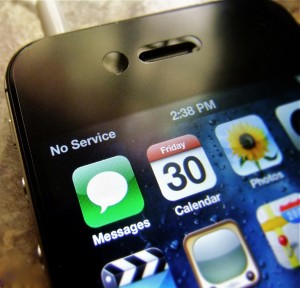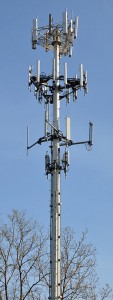Can You Hear Me Now?
– –
 Last month, as you may remember (Weathering The Storm), an ice storm caused a wide-spread power outage in our area. The power had been out for about three hours when Sarah noticed she didn’t have any service on her cell phone; Ryan and I checked ours and we didn’t either. Sarah managed to find one area in an upstairs room where she was able to get a weak and intermittent signal. Sure the power was out, but why wouldn’t we have cell phone coverage?
Last month, as you may remember (Weathering The Storm), an ice storm caused a wide-spread power outage in our area. The power had been out for about three hours when Sarah noticed she didn’t have any service on her cell phone; Ryan and I checked ours and we didn’t either. Sarah managed to find one area in an upstairs room where she was able to get a weak and intermittent signal. Sure the power was out, but why wouldn’t we have cell phone coverage?
After the storm was over I did some research and learned: Cellular services have antennas and base stations that require electricity. The FCC mandates that wireless carriers have backup electric power at MOST cell sites; so this typically means that cell towers have a battery backup system that will last two to four hours – depending on call traffic. In critical service areas there are also emergency generators. So, there are some redundancies built into the cellular network, but they’re limited and will be shortened if there is a lot of extra traffic on the network.
But I’ve been through other power outages and still had cell phone coverage, how come I didn’t this time? If the power outage is only covering a relatively small area, then most likely you’ll be able to connect to a tower outside of your area that still has power. Also, the priority locations for the cell towers are near the major urban areas; if you live in the suburbs or a rural area your cell towers will be further apart and less likely to have backup generators.
 How come XYZ provider, that my friend has, works and mine doesn’t? Though some providers may work in areas that others don’t, all providers have the same vulnerabilities. Their provider may have more backup power, or towers available, or fewer subscribers. But with the increased call volume, that frequently happens during a disaster, all cell network circuits can become congested causing delays, intermittently weaker signals, and no service.
How come XYZ provider, that my friend has, works and mine doesn’t? Though some providers may work in areas that others don’t, all providers have the same vulnerabilities. Their provider may have more backup power, or towers available, or fewer subscribers. But with the increased call volume, that frequently happens during a disaster, all cell network circuits can become congested causing delays, intermittently weaker signals, and no service.
So in these situations cell phones won’t work at all? Even if you can’t make a voice phone call you can still probably send a text message. Texting uses far less bandwidth, has little effect on circuits, and uses very little of your phone’s battery charge – and even if the text can’t go out (or be received) immediately, it is frequently held in the phone’s queue until it can be sent. Battery usage is another topic – but to maximize your battery turn off the ringer and vibration and reduce the screen’s brightness.
What about landlines, won’t they work? If your landline is provided through a traditional phone line you will continue to have service, but only to your phones which are hard-wired into the wall – your cordless phones won’t work (the base station requires electricity). But if your phone service is provided by a cable TV company (like ours is) the digital “landline” is run through a modem that requires electricity; which means no electricity, no phone signal.
Could you plug the modem into a backup power source? I didn’t think of this until afterward; I assume it would work, but I need to test it.
So what’s the solution? I’m not sure I have a good fix for all this yet, but we’ll work on it. This situation does emphasize how much we take instantaneous communication for granted. Make a family plan that includes where to meet in an emergency, and where to leave a note if you have to leave before others arrive. Take some time and think about how you could communicate with your loved ones if cell phones weren’t an option – we did it for a lot of years, do we still remember how?

Having recently moved into our home, I discovered that the traditional “land line” was no longer offered. If I was a long term resident that had one, great. But new customers could no longer get them. They are switching everything over to fiber optic/modem phone service. Mine does have a backup battery that came with it, but again that is only going to last so long. This is one of those downfalls of us become a technologically based society.
I hadn’t heard that it wasn’t even an option in some areas. I can understand the cost/benefit side for the companies, but it’s interesting to see “real” phones kind of disappearing for good.
Even landlines can still go down in a disaster, point in fact, in the same ice storm the tree branch that took out power also took out the phone line! Of course the phone company came out and fixed it a lot sooner than the power company (less than 24 hours compared to 96 hours for PSE). Really the best is to have alternate communications (radios, runners, smoke signals, tin cans and strings, etc.)
Another interesting thing that happened during the storm was that it took out the neutral and one of the hots off the pole, however the other hot was still connected and providing about 30 VAC to the house (it was using ground as the return neutral back to the pole, lost of resistance) which was enough to power the internet modem and electric keyboard so even without power we could browse the web and play music at the house.
You’re exactly right, communications can and do fail (most likely when you need them the most). There must be a back-up plan of some type in place. That’s also interesting how one part came down, but you still had partial usage.
Very interesting article. Thanks for sharing. I plugged in my phone to charge just now, even though it was halfway full, thinking just in case I need it after work before I get to a charger. That “just in case” randomly reminded me of the northeast blackout of 2002, where my area in Michigan and large areas of other states (like OH, NY, PA) lost power for several days. I remember using my cell phone back then, and trying to be very careful because I didn’t have a car charger for it.
When I reminisced about that situation just now, I analyzed it a little more in depth. I’ve been watching that show “Revolution”, and it really makes me think (or worry, actually) about losing power on a massive scale. I was thinking that cell phone batteries could be stretched out for a limited time by turning the power off, turning down brightness and all that. But then it occurred to me… don’t the cell sites need power? How can the cell signal be distributed amongst the phones without an energy source?
That question brought me to Google, and to your article. It was very well written and I thank you for doing the research and sharing the information.
I did want to mention that for those of you that have a landline through a cable company, the modem that handles the telephone signal MAY have a battery backup. Last year I convinced my grandma to drop the landline and bundle it with her cable, but she was very hesitant because she likes having a landline during a power outage. I called the cable company (WOW! in our area), and they indicated their modem has a battery with a 3-4 hour lifespan, that will obviously vary depending on how much it is used. I thought this info might be useful to you and your readers and wanted to share it. Obviously that 3-4 hour time is very iffy, because you not only have to consider the amount of usage you place on it, but how reliable the battery is, considering they lose their ability to hold a charge as they get older.
Yep, like I mentioned this was new material to me. We depend on our cell phones so much now, most of us (especially the younger generation) would struggle to survive without it. Knowing it’s limitations and having backups in place is very important.
I have a DSL (copper wire) Modem/Router/Wifi that is powered by a 12VDC battery (24/7) that is charged by a couple of cheap Harbor Freight (15 Watt) Solar Panels through a Charge Controller. The Edison Co. electricity goes out all the time, but with my set-up, I always have had an internet connection. I can use my laptop which has it’s own battery and/or run the laptop off a 12VDC to 110AC Inverter. Those with Cable (TV/phone/internet) and sometimes Cell Phones are S-O-L in my part of the woods.
Sounds like an uncomplicated, workable setup. The key is to have a plan.